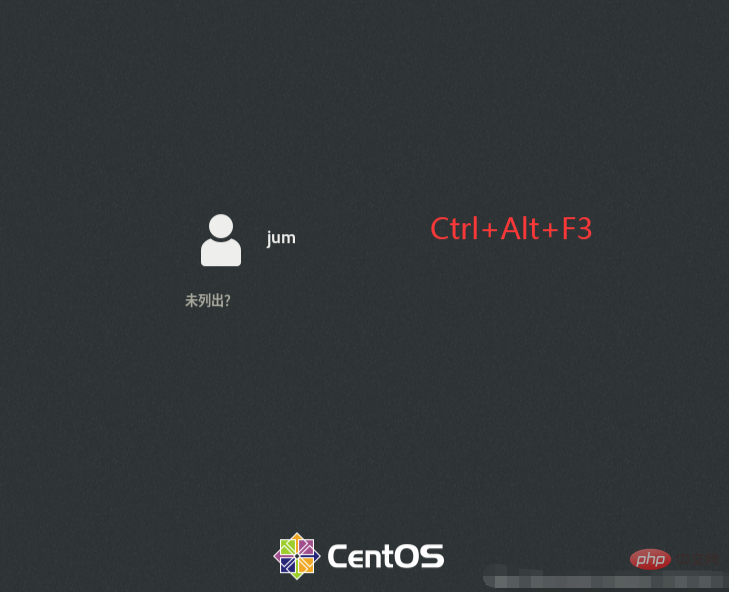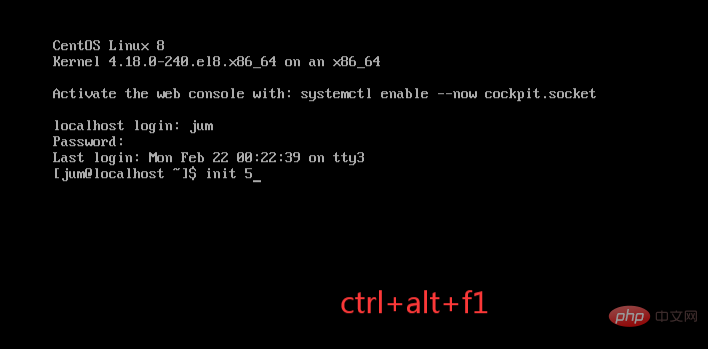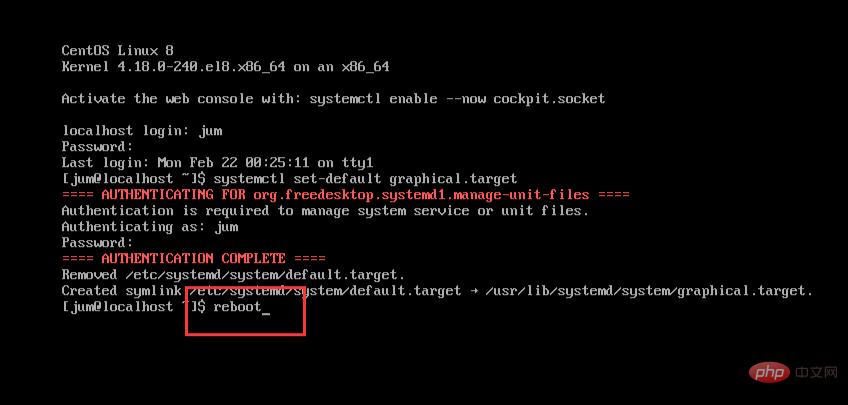 Operation and Maintenance
Operation and Maintenance
 Linux Operation and Maintenance
Linux Operation and Maintenance
 What two operating environments does linux provide?
What two operating environments does linux provide?
What two operating environments does linux provide?
Linux provides two operating environments: 1. Graphical user environment, which is a graphical interface that uses icons, menus and mice to complete operations; 2. Command line environment, which is a text interface , users can complete operations by entering commands, and is often used in server systems or remote operations because it is usually faster, simpler, and more stable than graphical interfaces. The Linux system provides a command line terminal (terminal) by default, and users can use it to perform command line operations.

The operating environment of this tutorial: CentOS7 system, Dell G3 computer.
Linux, the full name of GNU/Linux, is a UNIX-like operating system that is free to use and freely disseminated. Its kernel was developed by Linus Benedict Torvalds in 1991. First released on October 5, 2018, it is mainly inspired by the ideas of Minix and Unix. It is a multi-user, multi-task, multi-threading and multi-CPU operating system based on POSIX. It supports 32-bit and 64-bit hardware and can run major Unix software tools, applications and network protocols.
Two operating environments provided by linux
Linux operating system usually provides users with two different operating environments (interfaces): graphical user interface (GUI) and command line interface (CLI).
Graphical User Interface (GUI): A graphical user interface is a graphical interface that uses icons, menus, and the mouse to complete operations. Most Linux distributions include a graphical desktop environment, such as Gnome, KDE, Xfce, etc., that users can use to operate.
-
Command Line Interface (CLI): The command line interface is a text interface that allows users to complete operations by entering commands. The Linux system provides a command line terminal by default, which users can use to perform command line operations. The command line interface is often used in server systems or remote operations because it is usually faster, simpler, and more stable than a graphical interface.
Both interfaces have their own advantages and disadvantages. Users can choose which interface to use according to their own needs. In some cases, users can also use both interfaces at the same time. For example, you can use the graphical interface for day-to-day operations and the command-line interface to perform specific tasks or debug problems.
Command line mode and graphics mode switching method
The first graphics conversion command line
1. Press ctrl alt f3 on the system interface

2. Enter the command line interface and enter the account password.

Note: If a login incorrect problem occurs, please check whether the password is not completely entered due to the use of small keyboard numbers when entering the password. It is recommended to use a plain English password.

The second graphical change command line
1. Switch the graphical interface to the command line and enter the command [systemctl set-default multi-user.target] Then enter reboot to restart.

#2. After restarting, it will be in command line mode.
The first command line to change graphics
In command line mode, press ctrl alt f1

The second command line to change graphics
1. The command to switch the command line to a graphical interface [systemctl set-default graphical.target].

2. Then enter reboot to restart

Two simple CentOS7 command line modes and graphical modes The switching method has been introduced. Let’s try it.
Related recommendations: "Linux Video Tutorial"
The above is the detailed content of What two operating environments does linux provide?. For more information, please follow other related articles on the PHP Chinese website!

Hot AI Tools

Undresser.AI Undress
AI-powered app for creating realistic nude photos

AI Clothes Remover
Online AI tool for removing clothes from photos.

Undress AI Tool
Undress images for free

Clothoff.io
AI clothes remover

Video Face Swap
Swap faces in any video effortlessly with our completely free AI face swap tool!

Hot Article

Hot Tools

Notepad++7.3.1
Easy-to-use and free code editor

SublimeText3 Chinese version
Chinese version, very easy to use

Zend Studio 13.0.1
Powerful PHP integrated development environment

Dreamweaver CS6
Visual web development tools

SublimeText3 Mac version
God-level code editing software (SublimeText3)

Hot Topics
 Linux Architecture: Unveiling the 5 Basic Components
Apr 20, 2025 am 12:04 AM
Linux Architecture: Unveiling the 5 Basic Components
Apr 20, 2025 am 12:04 AM
The five basic components of the Linux system are: 1. Kernel, 2. System library, 3. System utilities, 4. Graphical user interface, 5. Applications. The kernel manages hardware resources, the system library provides precompiled functions, system utilities are used for system management, the GUI provides visual interaction, and applications use these components to implement functions.
 How to check the warehouse address of git
Apr 17, 2025 pm 01:54 PM
How to check the warehouse address of git
Apr 17, 2025 pm 01:54 PM
To view the Git repository address, perform the following steps: 1. Open the command line and navigate to the repository directory; 2. Run the "git remote -v" command; 3. View the repository name in the output and its corresponding address.
 How to run java code in notepad
Apr 16, 2025 pm 07:39 PM
How to run java code in notepad
Apr 16, 2025 pm 07:39 PM
Although Notepad cannot run Java code directly, it can be achieved by using other tools: using the command line compiler (javac) to generate a bytecode file (filename.class). Use the Java interpreter (java) to interpret bytecode, execute the code, and output the result.
 What is the main purpose of Linux?
Apr 16, 2025 am 12:19 AM
What is the main purpose of Linux?
Apr 16, 2025 am 12:19 AM
The main uses of Linux include: 1. Server operating system, 2. Embedded system, 3. Desktop operating system, 4. Development and testing environment. Linux excels in these areas, providing stability, security and efficient development tools.
 How to run sublime after writing the code
Apr 16, 2025 am 08:51 AM
How to run sublime after writing the code
Apr 16, 2025 am 08:51 AM
There are six ways to run code in Sublime: through hotkeys, menus, build systems, command lines, set default build systems, and custom build commands, and run individual files/projects by right-clicking on projects/files. The build system availability depends on the installation of Sublime Text.
 vscode Previous Next Shortcut Key
Apr 15, 2025 pm 10:51 PM
vscode Previous Next Shortcut Key
Apr 15, 2025 pm 10:51 PM
VS Code One-step/Next step shortcut key usage: One-step (backward): Windows/Linux: Ctrl ←; macOS: Cmd ←Next step (forward): Windows/Linux: Ctrl →; macOS: Cmd →
 laravel installation code
Apr 18, 2025 pm 12:30 PM
laravel installation code
Apr 18, 2025 pm 12:30 PM
To install Laravel, follow these steps in sequence: Install Composer (for macOS/Linux and Windows) Install Laravel Installer Create a new project Start Service Access Application (URL: http://127.0.0.1:8000) Set up the database connection (if required)
 How to use VSCode
Apr 15, 2025 pm 11:21 PM
How to use VSCode
Apr 15, 2025 pm 11:21 PM
Visual Studio Code (VSCode) is a cross-platform, open source and free code editor developed by Microsoft. It is known for its lightweight, scalability and support for a wide range of programming languages. To install VSCode, please visit the official website to download and run the installer. When using VSCode, you can create new projects, edit code, debug code, navigate projects, expand VSCode, and manage settings. VSCode is available for Windows, macOS, and Linux, supports multiple programming languages and provides various extensions through Marketplace. Its advantages include lightweight, scalability, extensive language support, rich features and version





